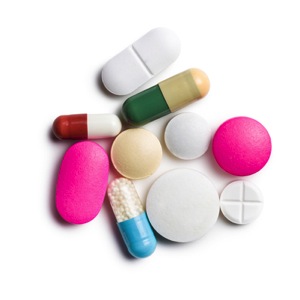
So you're officially gluten-free. You have your kitchen and shopping lists dialed in and you know how to look for hidden gluten in packaged foods. Ready to go! But wait — did you know that some body products and household items, as well as over-the-counter (OTC) and prescription medications contain hidden gluten? These items can be the source for ongoing immune activation for those with celiac disease and non-celiac gluten sensitivity. Additionally, many people with autoimmune conditions experience cross-reactions with corn, a filler used in many medications that the body can mistake for gluten.
Keeping Gluten Out Of Medications and Supplements
Most medications and many supplements contain fillers or excipients that perform several functions: they provide bulk, lubricate ingredients, or help the tablet disintegrate in the gut. Many of these ingredients are sourced from wheat, barley, or corn. Cross-contamination in the factory can also be an issue.
The FDA monitors active ingredients closely; excipients, however, are only required to be an FDA-approved substance. We assume brand name and generic drugs will be the same, but in fact, generic drug fillers may be different than the brand name version. This means you need to read the label to determine GF status. In addition, manufacturers change the inactive ingredients in products regularly, so a periodic check of ingredients is necessary on all products. Tip: keep an eye out for labeling changes that include "New and improved," "New formulation," "New product appearance," or "New manufacturer."
Apparently, some diabetes medications contain gluten; while a diabetic may not be sensitive to gluten in the same way as someone with celiac disease, gluten has been shown to cross-react with pancreatic islet cells (in the case of Type 1 diabetes). Some thyroid meds also have gluten or corn fillers, which cause immune cross-reactions for patients.
Below are some commonly used excipients and their sources:
- Pre-gelatinized starch (corn, wheat, potato, tapioca)
- Sodium starch glycolate (commonly potato, but has other starch sources) (Any product containing pre-gelatinized starch and sodium starch glycolate are to be avoided if not specifically labeled GF)
- Be on the lookout for any starches; they are primarily derived from corn, potato, and tapioca, however they have been known to contain starch from wheat
- Maltodextrin (corn, wheat, potato, rice)
- Dextri-maltose (barley malt)
- Dextrins (primarily corn and potato, but can come from wheat, rice, tapioca)
- Dextrans (sugar)
- Dextrose (corn starch)
- Dextrate (starch — source not listed)
- Maltodextrin (corn, wheat, potato, rice)
- Sodium starch glycolate (commonly potato; can come from any starch source)
Useful Tips for Avoiding Hidden Gluten In Medications
1. Read those ingredient labels! Become familiar with gluten/corn-based fillers. Keep an eye out for key labeling terms that indicate the need for deeper inspection!
2. If uncertain, ask your pharmacist. Although drug experts, pharmacists may not know the source for an ingredient and may need to call the producer to ask.
3. Call the drug company yourself. Ask your pharmacist for the number or find it online.
4. Ask ahead about hospital medications; some inpatient meds for surgery, radiology and other procedures contain gluten. Explain the potential risks to your health and demand verification.
5. Remind your doctor that you will be checking into the GF status of your medications and ask for first- and second-choice medications. This can save you time and help avoid problematic gaps in medication.
6. When generic medication is available your insurance company may not approve brand name labels. If you need to go with the brand name for health reasons, call your insurance company and ask how to obtain approval for the more expensive medication.
7. If you require an unusual medication that does not offer a GF option, find a compounding pharmacy that will make a custom GF medication for you.
8. Remember to periodically re-confirm the GF status of your medications and supplements.
What About the Rest of the House?
Manufacturers often use gluten or wheat flour to aid the manufacturing process for non-food items, such as fillers, lubricants or absorbents, and gluten-based ingredients are common in certain body products. While gluten is not absorbed through the skin, it is possible to transfer traces from your hands or face to your mouth, where it can be swallowed and cause a reaction. Children are prone to putting fingers and items they touch in their mouths, so monitor them closely if they have a gluten sensitivity.
Below are some common body and household items that can have hidden gluten. Look for a GF label, and if you see an unfamiliar ingredient, don't hesitate to call the company and ask about its source:
- Lip stick and lip balm
- Sunscreen
- Children’s stickers
- Price tag stickers
- Stamps and envelopes
- Cough syrup
- Shampoo
- Toothpaste
- Lotions
- Soaps
- Mouthwash
- Cosmetics
- Play dough
- Laundry detergent
- Pet food
As you can see, gluten can lurk in plenty of places past the dinner plate, potentially throwing a wrench in your gluten-free lifestyle. If you are gluten-free yet still experience gluten-related symptoms, it is worth checking the labels on all medications, supplements, and household and body products for ingredients that contain gluten. With good label-reading habits and an eye for hidden gluten, you can create a safe and healthy gluten-free environment for you and your family.



Latest from the Blog
The Death of Red Dye #3
January 15, 2025What Is Red Dye No. 3? Red Dye No. 3, or Erythrosine, is a synthetic food color derived from coal tar. It was first approved by the FDA in the 1950s and quickly became one of the most popular artificial colors in food and cosmetics. Red Dye No. 3 was used in everything from candies, […] Read more
Latest from the Blog
Do You Know What Is In Your Protein Powder?
What’s Really in Your Protein Powder? Understanding the Risks Protein powders are a staple in many health-conscious diets, from athletes seeking muscle recovery to those simply aiming to boost their daily protein intake. With a wide variety of options available, choosing the right one can feel overwhelming. However, recent findings have raised concerns about what’s […] Read more